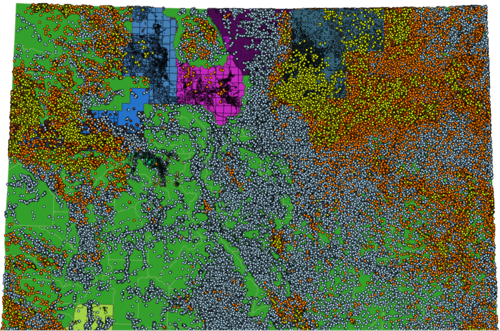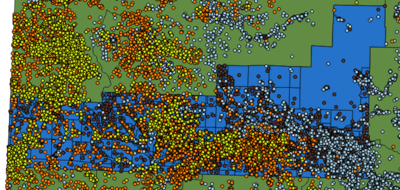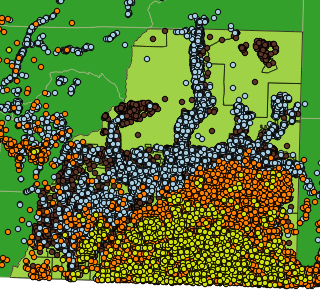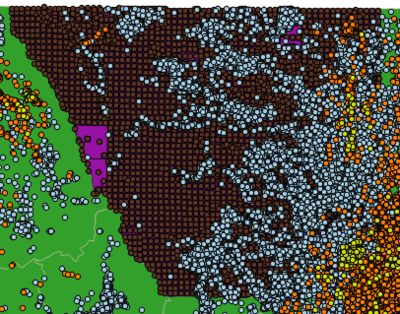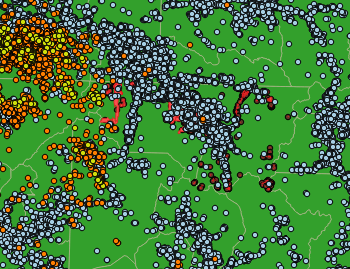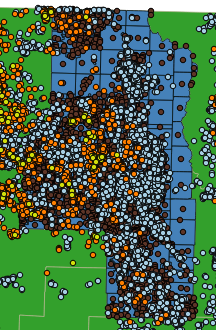Fracking and property values in Colorado
With several proposed 2016 ballot measures attempting to regulate where and how fracking occurs in Colorado, Ballotpedia undertook a study and found no definitive evidence that fracking negatively impacted home values and sales across seven counties in Colorado in 2015. One proposed ballot measure would require all oil and gas wells to be a minimum of 2,500 feet from any occupied structures, including homes. Supporters of this and similar measures have said that the measures were proposed on the premise that home values are negatively impacted by oil and gas development. Proponents of this measure had until August 8, 2016, to gather the required 98,492 signatures to get the measure on the November ballot. The measure did not ultimately make the November 2016 ballot.[1][2][3][4][5]
To conduct this study, Ballotpedia collected data from county assessor's offices for seven counties in Colorado—Garfield, Grand, La Plata, Larimer, Pitkin, Routt, and Weld—and separated that data into the following categories:
- home sales occurring within 180 days (before and after) of an oil or gas well being drilled
- home sales and values for homes within 1,000 feet of an oil or gas well
- home sales and values for homes within 1,000 feet of an oil or gas well on private water
- home sales and values for homes within 1,000 feet of an oil or gas well on public water
The map the right shows the seven counties randomly picked for this study highlighted in green. Click on a highlighted county to see that county's median home value and sale.
Results
Click on a county's tab for the results for that county. All data are median values, or the midpoint of the data, indicating that half of all values are greater than this amount and half of all values are less than this amount. Home sales or values that were less than $1,000 or more than $1,000,000 were excluded, as were homes with 20 or more acres of land. To review the data for a county, click on that county's tab below.
It is important to keep in mind the difference in number of properties when making comparisons. For example, in Garfield County, Colorado, there were 105 homes that had a well drilled within 180 days of a home sale and 6,443 homes that did not have a well drilled during that time period. Because of how uncommon it was to have a well drilled during the time of a sale, there are relatively few instances compared to the overall number of home sales, and direct comparisons may not be accurate due to the differences in sample size.
Summary
The table below shows the total number of properties for each county, the number of oil or gas wells that were within 1,000 of a property, and the percent of homes with a well within 1,000 feet. Due to the outliers we removed (as mentioned above) and data availability, some counties had more properties available for review than others. When making comparisons, it is important to keep in mind the total number of homes. For example, there are few instances of a well being drilled within 180 days of a home being sold, making comparisons between those homes and other homes difficult. Additionally, no controls were put into place for the characteristics of the home, making one-to-one comparisons difficult.
| Data summary | ||||
|---|---|---|---|---|
| County | Properties included in study | Wells within 1,000 feet of a home | Percent of homes with well within 1,000 feet | Properties with a well drilled within 180 days of a sale |
| Garfield | 6,548 | 2,466 | 37.66% | 105 |
| Grand | 2,970 | 1,115 | 37.54% | 1 |
| La Plata | 11,573 | 2,387 | 20.63% | 50 |
| Larimer | 636 | 155 | 24.37% | 0 |
| Pitkin | 1,176 | 1 | 0.09% | 0 |
| Routt | 4,362 | 11 | 0.25% | 0 |
| Weld | 39,585 | 26,402 | 66.70% | 367 |
| Total | 66,850 | 32,537 | -- | 523 |
| Median | 4,362 | 1,115 | 24.37% | 1 |
Garfield
| Oil and gas well drilling within 180 days of a home sale | |||
|---|---|---|---|
| Drilling during sale | Number of properties | Median home sale | |
| Yes | 105 | $220,000 | |
| No | 6,443 | $290,000 | |
| Oil and gas well within 1,000 feet of home | |||
|---|---|---|---|
| Well within 1,000 feet of home | Number of properties | Median home sale | Median home value |
| Yes | 2,466 | $220,000 | $160,000 |
| No | 4,002 | $340,000 | $250,000 |
| Oil and gas well 1,000 feet of home and water use | |||
|---|---|---|---|
| Private water well | |||
| Well within 1,000 feet of home | Number of properties | Median home sale | Median home value |
| Yes | 324 | $380,000 | $250,000 |
| No | 28 | $330,000 | $220,000 |
| Public water | |||
| Yes | 6,069 | $290,000 | $220,000 |
| No | 127 | $290,000 | $140,000 |
Grand
| Oil and gas well drilling within 180 days of a home sale | |||
|---|---|---|---|
| Drilling during sale | Number of properties | Median home sale | |
| Yes | 1 | $76,000 | |
| No | 2969 | $320,000 | |
| Oil and gas well within 1,000 feet of home | |||
|---|---|---|---|
| Well within 1,000 feet of home | Number of properties | Median home sale | Median home value |
| Yes | 1,115 | $410,000 | $55,000 |
| No | 1,855 | $290,000 | $40,000 |
| Oil and gas well 1,000 feet of home and water use | |||||||
|---|---|---|---|---|---|---|---|
| Private water well | Public water | ||||||
| Well within 1,000 feet of home | Number of properties | Median home sale | Median home value | Well within 1,000 feet of home | Number of properties | Median home sale | Median home value |
| Yes | 50 | $330,000 | $67,000 | Yes | 1,065 | $410,000 | $54,000 |
| No | 420 | $300,000 | $58,000 | No | 1,435 | $290,000 | $40,000 |
La Plata
| Oil and gas well drilling within 180 days of a home sale | |||
|---|---|---|---|
| Drilling during sale | Number of properties | Median home sale | |
| Yes | 50 | $230,000 | |
| No | 11,523 | $250,000 | |
| Oil and gas well within 1,000 feet of home | |||
|---|---|---|---|
| Well within 1,000 feet of home | Number of properties | Median home sale | Median home value |
| Yes | 2,387 | $230,000 | $86,000 |
| No | 9,186 | $250,000 | $100,000 |
| Oil and gas well 1,000 feet of home and water use | |||||||
|---|---|---|---|---|---|---|---|
| Private water well | Public water | ||||||
| Well within 1,000 feet of home | Number of properties | Median home sale | Median home value | Well within 1,000 feet of home | Number of properties | Median home sale | Median home value |
| Yes | 882 | $200,000 | $88,000 | Yes | 1,505 | $250,000 | $84,000 |
| No | 1,802 | $230,000 | $90,000 | No | 7,384 | $250,000 | $110,000 |
Larimer
Home sales and valuation data for Larimer County were only available for homes that had been sold between September 2009 to December 2015.
| Oil and gas well drilling within 180 days of a home sale | |||
|---|---|---|---|
| Drilling during sale | Number of properties | Median home sale | |
| No sales | No sales | No sales | |
| No sales | No sales | No sales | |
| Oil and gas well within 1,000 feet of home | |||
|---|---|---|---|
| Well within 1,000 feet of home | Number of properties | Median home sale | Median home value |
| Yes | 155 | $280,000 | $250,000 |
| No | 481 | $330,000 | $320,000 |
| Oil and gas well 1,000 feet of home and water use | |||||||
|---|---|---|---|---|---|---|---|
| Private water well | Public water | ||||||
| Well within 1,000 feet of home | Number of properties | Median home sale | Median home value | Well within 1,000 feet of home | Number of properties | Median home sale | Median home value |
| Yes | No wells | No wells | No wells | Yes | 155 | $280,000 | $250,000 |
| No | No wells | No wells | No wells | No | 481 | $330,000 | $320,000 |
Pitkin
| Oil and gas well drilling within 180 days of a home sale | |||
|---|---|---|---|
| Drilling during sale | Number of properties | Median home sale | |
| No sales | No sales | No sales | |
| No sales | No sales | No sales | |
| Oil and gas well within 1,000 feet of home | |||
|---|---|---|---|
| Well within 1,000 feet of home | Number of properties | Median home sale | Median home value |
| Yes | 1 | $76,000 | $170,000 |
| No | 1,175 | $380,000 | $460,000 |
| Oil and gas well 1,000 feet of home and water use | |||||||
|---|---|---|---|---|---|---|---|
| Private water well | Public water | ||||||
| Well within 1,000 feet of home | Number of properties | Median home sale | Median home value | Well within 1,000 feet of home | Number of properties | Median home sale | Median home value |
| Insufficient data | Insufficient data | Insufficient data | Insufficient data | Insufficient data | Insufficient data | Insufficient data | Insufficient data |
| Insufficient data | Insufficient data | Insufficient data | Insufficient data | Insufficient data | Insufficient data | Insufficient data | Insufficient data |
Routt
| Oil and gas well drilling within 180 days of a home sale | |||
|---|---|---|---|
| Drilling during sale period | Number of properties | Median home sale | |
| Insufficient data | Insufficient data | Insufficient data | |
| Insufficient data | Insufficient data | Insufficient data | |
| Oil and gas well within 1,000 feet of home | |||
|---|---|---|---|
| Well within 1,000 feet of home | Number of properties | Median home sale | Median home value |
| Yes | 22 | $140,000 | $170,000 |
| No | 4,340 | $320,000 | $240,000 |
| Oil and gas well 1,000 feet of home and water use | |||||||
|---|---|---|---|---|---|---|---|
| Private water well | Public water | ||||||
| Well within 1,000 feet of home | Number of properties | Median home sale | Median home value | Well within 1,000 feet of home | Number of properties | Median home sale | Median home value |
| Yes | 7 | $120,000 | $200,000 | Yes | 15 | $190,000 | $150,000 |
| No | 406 | $290,000 | $250,000 | No | 4,041 | $320,000 | $230,000 |
Weld
| Oil and gas well drilling within 180 days of a home sale | |||
|---|---|---|---|
| Drilling during sale | Number of properties | Median home sale | |
| Yes | 367 | $190,000 | |
| No | 39,218 | $210,000 | |
| Oil and gas well within 1,000 feet of home | |||
|---|---|---|---|
| Well within 1,000 feet of home | Number of properties | Median home sale | Median home value |
| Yes | 26,402 | $220,000 | $210,000 |
| No | 13,183 | $190,000 | $180,000 |
| Oil and gas well 1,000 feet of home and water use | |||||||
|---|---|---|---|---|---|---|---|
| Private water well | Public water | ||||||
| Well within 1,000 feet of home | Number of properties | Median home sale | Median home value | Well within 1,000 feet of home | Number of properties | Median home sale | Median home value |
| Yes | 677 | $200,000 | $210,000 | Yes | 25,725 | $220,000 | $210,000 |
| No | 320 | $210,000 | $240,000 | No | 12,863 | $190,000 | $180,000 |
Background
Home values
Home values are influenced by a wide variety of factors, including location, the value of comparable homes, amenities (e.g., kitchen or bathroom upgrades, a pool), the condition of the home, the neighborhood (e.g., surrounding homes, nearby businesses), the school district, crime rates, etc. In Colorado, county assessors appraise the value of a home by comparing that home to homes with similar amenities, design, size, and location characteristics. Value is also determined by comparing home sales for similar homes that occurred in the months prior to the appraisal date (in most cases for these data, that date is June 30, 2014).[6][7]
The increased oil and gas production spurred by fracking has increased the number of wells in residential areas and raised questions about how oil and gas wells can affect home values. Colorado is also undergoing a population boom. From June 2013 to June 2014, the state's population grew by 1.59 percent, meaning the state ranked fourth in the nation in terms of overall population growth. While increased oil and gas production may mean more wells are being drilled near homes, it may also mean that more homes are being built near wells. Additionally, home prices are rising quickly in Colorado. According to the CoreLogic HomePrice Index, from February 2014 to February 2015, home prices in Colorado rose by 8.9 percent—the highest increase in the United States. Much of this growth has been driven by home sales in the Denver area, where the median home sale was $300,000 in March 2015, according to real estate service REColorado.[8][9]
The process to drill a well typically takes 60 days, and during this time there are several environmental impacts—including road construction, light and drilling noise, and increased traffic—that could affect the value of a home. Concern over potential environmental impacts could also affect the value of a home, such as the fear of water contamination (especially if a home uses private water wells), oil spills, and pipeline leaks. According to the U.S. Environmental Protection Agency in 2015, fracking has not "led to widespread, systemic impacts on drinking water resources in the United States." While the number of cases where drinking water wells were contaminated by fracking is small, concern over potential contamination could impact the value of a home. There have been several academic studies (summarized here) evaluating the impact that fracking has on home values. While these studies have their limitations, they do offer the best research available on the topic.[10][11]
Fracking
- Main article: Fracking in Colorado
In 2014, Colorado ranked seventh in the nation for crude oil production, while in 2013 the state also ranked seventh in the nation in terms of natural gas production. This increase in production has been brought on by a combination of fracking and horizontal drilling. Colorado's move into the top 10 oil- and gas-producing states has not been without contention; disputes have arisen over the economic, environmental, and political tradeoffs. One question this study does not address is how the drop in the price of crude oil has affected home values, if at all. As of April 5, 2016, the full impact of that drop remained to be seen.[12][13][14]
Hydraulic fracturing, or "fracking," is the process of injecting fluid—approximately 99.5 percent water and sand with 0.5 percent additional chemicals—into the ground at a high pressure to fracture shale rocks and release the crude oil and natural gas inside. The increased use of fracking has been an economic boon for many states, not only those with fracking, but also those with supporting industries such as frac sand mining or associated machinery manufacturing. As with any type of energy extraction, there are risks involved.[15][16][17]
Opponents of fracking argue that the potential negative environmental and human health impacts could be significant. Although wells have been fracked for over 65 years in the United States, concerns have been raised about whether federal, state, and local regulatory agencies can keep up with the recent rapid increase in fracking activity and adequately protect the environment and human health.[17]
Proponents of fracking argue that fracking is a safe process and that current regulations are sufficient to protect water resources, land, and human health. Recent studies from several universities have had similar findings to the EPA, which stated that "the number of identified cases [where fracking contaminated groundwater], however, was small compared to the number of hydraulically fractured wells."[11][18]
Method
We collected the 2015 assessed value, address, previous sale date and price, and acreage for all residential land parcels from the county assessors in seven randomly selected counties in Colorado: Garfield, Grand, La Plata, Larimer, Pitkin, Routt, and Weld. All sales prices were updated to 2015 dollars, making comparisons between sales possible. These housing data were then paired with a county parcel boundary map based on a unique ID number.[19][20][21][22][23][24][25]
We also collected oil and gas well data from the Colorado Oil and Gas Conservation Commission. Private water well data were collected from the Colorado Department of Natural Resources. By pairing these files with our housing data, we were able to map and then calculate the distance from each home to the nearest oil or gas well, locate any wastewater pits within 1,000 feet of the home, and determine whether the home had an active private water well permit. In order to compare homes that sold while a well was being drilled to homes without drilling, we had to set a cut-off date. Similar to the studies below, we chose 180 days (six months) both before and after a home was sold as the limit for our variable intended to capture the effect that drilling has on home sales. Homes with active water well permits were assumed to be on private well water and all other homes were assumed to be on public water.[26][27][28]
Conclusion
Property values are affected by a wide array of factors, making it difficult to isolate the effect of one factor on home prices. The data below show that home sale prices were lower for homes that had a well drilled within 180 days of a sale. The differences in sample size between homes with drilling and without is quite large, making it an imprecise metric to use for comparison.
When it comes to the proximity of active oil or gas wells, there is no definitive evidence that fracking impacted 2015 home values across the seven Colorado counties below. Some homes closer to the wells in four counties had lower sale prices and values, while in two counties, they had higher sale prices and values. Homes on private water with an oil or gas well within 1,000 feet also had higher sale prices and/or values for two counties and lower for three counties, with two counties having insufficient data. In two cases, homes presumed to be using public water had the same sale price, whether there was a well within 1,000 feet or not. In three counties the value was lower for homes close to an oil or gas well, while in two counties the sale prices were lower. In three cases the value was higher for homes within 1,000 feet of a well and on public water, with sales prices higher for two counties under the same conditions.
The table below shows whether home prices were higher or lower for homes that had an oil or gas well drilled within 180 days before and after the home was sold. In three counties—Larimer, Pitkin, and Routt—there were either no sales or so few sales that a comparison couldn't be made. The other three counties for which data were available are not necessarily good comparisons because of the difference in sample sizes. On average, there was a difference of 18,887 homes between sales with drilling and without drilling.
| Were home prices higher or lower when a well was drilled within 180 days of a sale? | |||
|---|---|---|---|
| County | Type | Comparison | Difference |
| Garfield | Sale | lower | -$50,000 |
| Grand | Sale | Insufficient data | -- |
| La Plata | Sale | lower | -$20,000 |
| Larimer | Sale | Insufficient data | -- |
| Pitkin | Sale | Insufficient data | -- |
| Routt | Sale | Insufficient data | -- |
| Weld | Sale | lower | -$20,000 |
This table compares home sale prices and values for homes that had an oil or gas well within 1,000 feet of a home. Garfield, La Plata, Larimer, and Routt counties had median home sale prices and values that were lower for homes with an oil or gas well within 1,000 feet. Grand and Weld counties, however, had higher median home sale prices and values for homes with an oil or gas well within 1,000 feet. Because there was only one oil or gas well in Pitkin data, the data are not presented below.
| Were home prices higher or lower when a well was within 1,000 feet? | |||
|---|---|---|---|
| County | Type | Comparison | Difference |
| Garfield | Sale | lower | -$120,000 |
| Grand | Sale | higher | +$120,000 |
| La Plata | Sale | lower | -$20,000 |
| Larimer | Sale | lower | -$50,000 |
| Pitkin | Sale | Insufficient data | - |
| Routt | Sale | lower | -$180,000 |
| Weld | Sale | higher | +$30,000 |
| Were home values higher or lower when a well was within 1,000 feet? | |||
| Garfield | Value | lower | -$90,000 |
| Grand | Value | higher | +$15,000 |
| La Plata | Value | lower | -$14,000 |
| Larimer | Value | lower | -$70,000 |
| Pitkin | Value | Insufficient data | - |
| Routt | Value | lower | -$70,000 |
| Weld | Value | higher | +$30,000 |
According to the table below, Garfield and Grand counties had homes using private water wells that were within 1,000 feet of an oil and gas well where the sale price and value of the homes were higher than homes not within 1,000 feet of an oil or gas well. La Plata, Routt, and Weld counties, meanwhile, had homes using private water wells that were within 1,000 feet of an oil and gas well where the sale price and value of the homes were lower than homes not within 1,000 feet of an oil or gas well. In Larimer County, there were no homes in our study using private water wells. Because there was only one oil or gas well in Pitkin County, the data are not presented below.
| Were home prices higher or lower when a home used private water and an oil or gas well was within 1,000 feet? | |||
|---|---|---|---|
| County | Type | Comparison | Difference |
| Garfield | Sale | higher | +$50,000 |
| Grand | Sale | higher | +$30,000 |
| La Plata | Sale | lower | -$30,000 |
| Larimer | Sale | No water wells | - |
| Pitkin | Sale | Insufficient data | - |
| Routt | Sale | lower | -$170,000 |
| Weld | Sale | lower | -$10,000 |
| Were home values higher or lower when a home used private water and an oil or gas well was within 1,000 feet? | |||
| Garfield | Value | higher | +$30,000 |
| Grand | Value | higher | +$9,000 |
| La Plata | Value | lower | -$2,000 |
| Larimer | Value | No water wells | - |
| Pitkin | Value | Insufficient data | - |
| Routt | Value | lower | -$50,000 |
| Weld | Value | lower | -$30,000 |
Two counties, Garfield and La Plata, had no difference in the sale price for homes using public water and within 1,000 feet of an oil or gas well. Grand and Weld counties had higher sale prices for homes using public water and within 1,000 feet of an oil or gas well. La Plata, Larimer, and Routt counties had lower sale prices for similar homes not within 1,000 feet of a well. Three counties had higher home values for homes within 1,000 feet of a well and on public water: Garfield, Grand, and Weld counties. Meanwhile, La Plata, Larimer, and Weld counties had lower values.
| Were home prices higher or lower when a home used public water and an oil or gas well was within 1,000 feet? | |||
|---|---|---|---|
| County | Type | Comparison | Difference |
| Garfield | Sale | same | $0 |
| Grand | Sale | higher | +$120,000 |
| La Plata | Sale | same | $0 |
| Larimer | Sale | lower | -$50,000 |
| Pitkin | Sale | Insufficient data | - |
| Routt | Sale | lower | -$130,000 |
| Weld | Sale | higher | +$30,000 |
| Were home values higher or lower when a home used public water and an oil or gas well was within 1,000 feet? | |||
| Garfield | Value | higher | +$80,000 |
| Grand | Value | higher | +$14,000 |
| La Plata | Value | lower | -$26,000 |
| Larimer | Value | lower | -$70,000 |
| Pitkin | Value | Insufficient data | - |
| Routt | Value | lower | -$80,000 |
| Weld | Value | higher | +$30,000 |
Previous studies
There have been several academic studies evaluating the impact that fracking has on home values. The table below shows the name of the study, a short summary of the outcome, and the study's authors and/or funders. Click "show" to see the full list.
Previous studies have found that, in general, having an oil or gas well within 1,000 feet to 1,500 feet of a home decreases that home's value. In the one instance where similar homes were studied over time, this effect was temporary. Property in areas with increased oil and gas activity may benefit from heightened economic activity in the area. Additionally, homes with oil or gas resources and the rights to access those resources are expected to see an increase in the value of that property. Each of these studies has its own limitations, including the fact that most of the following studies did not follow the value of the homes over time. Additionally, because home values are affected by such a wide array of factors, controlling for all of those impacts is very difficult. Ballotpedia's analysis is more qualified and instead leaves it up to the reader to draw their own conclusions.
| Studies of how fracking impacts property values | |||||
|---|---|---|---|---|---|
| Name of the study | Summary | Authors and affiliations | Published by or funding agency | Year published | Location studied |
| The Housing Market Impacts of Shale Gas Development | Using several statistical techniques, the authors find that the perception that fracking could contaminate groundwater decreased home values for homes within about one-half mile to one mile of an oil or gas well by an annual average of $30,167. Meanwhile, homes that used public water were positively impacted by increased oil and gas activity by an annual average of $4,802. | Lucija Muehlenbachs (Resources for the Future; University of Calgary); Elisheba Spiller (Environmental Defense Fund; Duke University); Christopher Timmins (Duke University) | American Economic Review (peer-reviewed) | 2016 | Pennsylvania |
| Economic Assessment Report for the Supplemental Generic Environmental Impact Statement on New York State’s Oil, Gas, and Solution Mining Regulatory Program | In the state's analysis of how fracking, if permitted, could affect New York State residents, the authors also predicted mixed results. Residents receiving payments from mineral lease holdings were expected to see an increase in their home values, while the disturbances and other intrusions of oil and gas activity were forecasted to negative affect home values (no exact dollar amounts were given). | Ecology and Environment Inc. | New York State of Environmental Conservation | 2011 | New York |
| Measuring the Impact of Coalbed Methane Wells on Property Values | Using data for La Plata County, Colorado, these authors studied the effects of coalbed methane on housing values. This study found that having an oil or gas well on a homeowner's property decreased the price, while having a well within 550 feet increased the price of a home. Wells had a negligible effect on homes that were 550 to 2,600 feet of a well. This study provided the impact using exact dollar amounts for several types of homes, more than can be quoted here. | BBC Research & Consulting | La Plata County, Colorado and Greystone Environmental Consultants, Inc. | 2001 | La Plata County, Colorado |
| The Impact of Oil and Natural Gas Facilities on Rural Residential Property Values: A Spatial Hedonic Analysis | Researchers studying home values in Alberta, Canada, found that sour wells (natural gas wells with higher than average hydrogen sulfide) and oil and gas industry facilities negatively affected home values. Pipelines, meanwhile, did not have a significant impact. The exact dollar amount of the impact varied based on the type of statistical tool employed. These figures are available in the study. | Peter C. Boxall (University of Alberta), Wing H. Chan (Wilfrid Laurier University), Melville L. McMillan (University of Alberta) | Laurier Business and Economics | 2005 | Alberta, Canada |
| A Review of Hydro "Fracking" and its Potential Effects on Real Estate | These researchers surveyed respondents in Texas and Florida, inquiring about how much fracking would lower the amount of money they would offer for a house. The authors found a 5 percent to 15 percent decrease in the value of the bid survey respondents offered given different levels of oil and gas activity. | Ron Throupe (University of Denver); Robert A. Simons (Cleveland State University); Xue Mao (University of Denver) | Journal of Real Estate Literature (peer-reviewed) | 2013 | Texas and Florida |
| Are Housing Prices Pulled Down or Pushed Up by Fracked Oil and Gas Wells? A Hedonic Price Analysis of Housing Values in Weld County, Colorado | Using home values for properties in Weld County, Colorado, the researchers found that homes were impacted differently depending on whether the residence was in an urban or rural location. The researchers found that wells within one-half mile of a home in a rural area had a significant impact on the home values. In urban areas, there was a decrease of 1 percent in the value of a home. | Ashley Bennett and John Loomis (Colorado State University) | Society and Natural Resources (peer-reviewed) | 2014 | Weld County, Colorado |
| Is the Shale Energy Boom a Bust for Nearby Residents? Evidence from Housing Values in Pennsylvania | Using housing data from 2008 to 2010, the authors found that fracking had a negative effect on property values. This effect was "largely transitory" and was larger if the home had private well water or was close to a highway. Exact figures are available for those with full access to the article. | Sathya Gopalakrishnan and H. Allen Klaiber (Ohio State University) | American Journal of Agricultural Economics | 2014 | Washington County, Pennsylvania |
| Flower Mound Well Impact Study | A review of properties in Flower Mound, Texas, found that homes valued at over $250,000 and within 1,000 feet of a well site were negatively impacted by 3 percent to 14 percent. If wells were visibly blocked from the view of the home, the impact was negligible. | Integra Realty Resources | Town of Flower Mound | 2010 | Flower Mound, Texas |
| “Valuation of Expectations: A Hedonic Study of Shale Gas and New York’s Moratorium” | This study finds that the 2008 statewide moratorium on hydraulic fracturing reduced New York property values by an estimated 23.1 percent, indicating “a positive and substantial valuation of [shale gas development]” in the state. | Andrew Boslett, Todd Guilfoos, and Corey Lang (University of Rhode Island) | Environmental and Natural Resource Economics, The University of Rhode Island | 2015 | New York |
See also
![]() See report: Fracking and property values in Colorado PDF version
See report: Fracking and property values in Colorado PDF version
Footnotes
- ↑ Real Vail, "Group floats 11 possible oil and gas drilling ballot questions," January 6, 2016
- ↑ The Los Angeles Times, "Deal will keep fracking battle off Colorado ballot," August 4, 2014
- ↑ Colorado Secretary of State, "2015-2016 Initiative filings, agendas & results," accessed February 26, 2016
- ↑ Colorado Secretary of State, "Results for Proposed Initiative #76," accessed March 30, 2016
- ↑ Colorado Oil and Gas Association, "Update on Proposed Anti-Oil and Gas Ballot Initiatives," accessed March 30, 2016
- ↑ SFGate, "What Affects the Appraisal Value of a House?" accessed February 22, 2016
- ↑ Garfield County, "Assessor FAQs," accessed December 9, 2016
- ↑ The Denver Post, "Colorado ranks fourth among states for population gains," December 23, 2014
- ↑ The Denver Post, "Colorado home prices rising at fastest rate in country," April 7, 2015
- ↑ SFGate, "What Affects the Appraisal Value of a House?" accessed February 22, 2016
- ↑ 11.0 11.1 U.S. Environmental Protection Agency, "Assessment of the Potential Impacts of Hydraulic Fracturing for Oil and Gas on Drinking Water Resources (External Review Draft)," June 4, 2015
- ↑ U.S. Energy Information Administration, "Crude Oil Production," July 31, 2015
- ↑ U.S. Energy Information Administration, "Natural Gas Gross Withdrawals and Production," July 31, 2015
- ↑ The Denver Post, "Oil under $30 a barrel carries dangers for Colorado economy," January 26, 2016
- ↑ Frack Wire, “What is Fracking,” accessed January 28, 2014
- ↑ Pennsylvania Geological Survey, "Oil and gas in Pennsylvania (3rd ed.): 4th ser., Educational Series 8," accessed September 22, 2015
- ↑ 17.0 17.1 University of Oklahoma, "Hydraulic Fracturing and Water Resources," accessed March 12, 2014
- ↑ This report is a draft version of the final report. The final report was released in December 2016 and can be found here.
- ↑ Garfield County Colorado, "Account Search," accessed November 23, 2015
- ↑ La Plat County Colorado, "Welcome to La Plata County, CO EagleWeb," accessed December 12, 2015
- ↑ Grand County Colorado, "Public User Login," accessed December 13, 2015
- ↑ Larimer County, "Public Records Databases," February 1, 2016
- ↑ Pitkin County Assessor, "Property Search," accessed January 23, 2016
- ↑ Routt County Assessor, "Welcome," accessed January 16, 2016
- ↑ Weld County Office of the Assessor, "Improved Property Sales Search," accessed January 28, 2016
- ↑ Colorado Oil and Gas Conservation Commission, "Downloads-Well Surface Location Data (Updated Daily)," accessed February 9, 2016
- ↑ Colorado Department of Natural Resources, Colorado's Decision Support Systems, "Data by Category," accessed March 30, 2016
- ↑ Kayla Harris, "Email communication with Colorado GIS Program Coordinator Chris Brown," November 9, 2015
| |||||||||||



